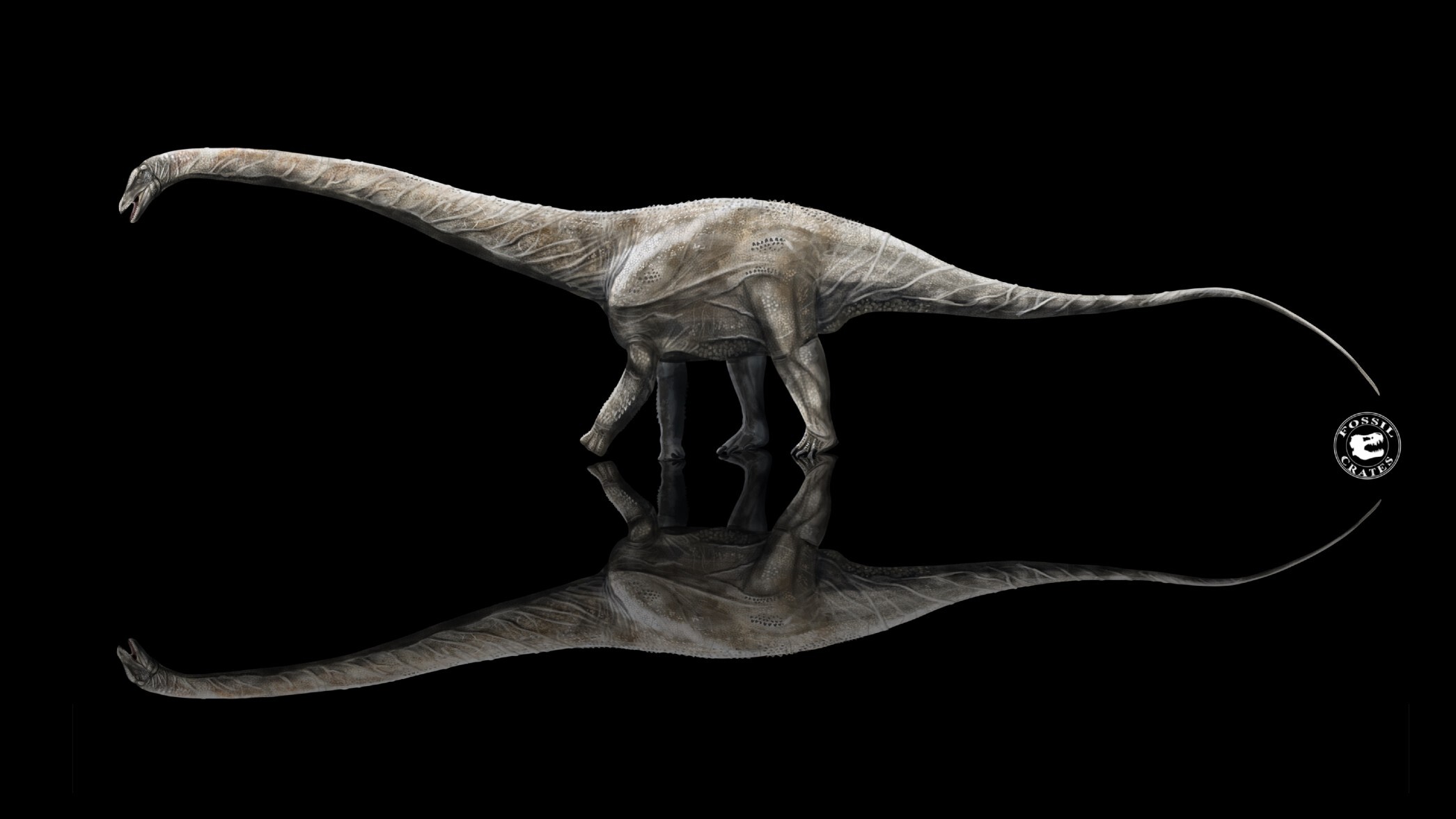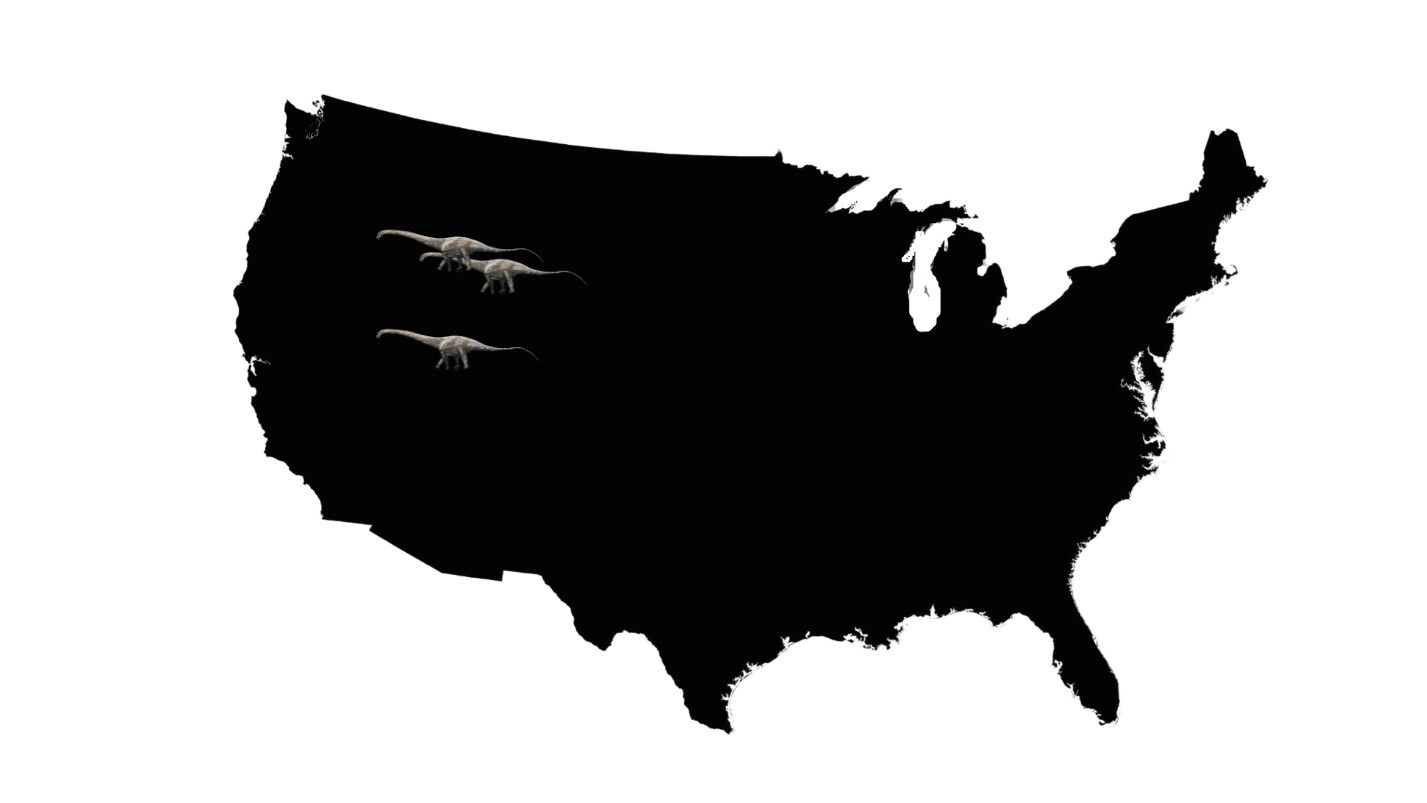Supersaurus might be the longest dinosaur that ever lived
This dino-mite champ was at least 128 feet long.
The gold medal for the longest dinosaur in the world might go to the aptly named Supersaurus, now that scientists have fixed a fossil mix-up and analyzed new bones excavated from the long-necked dinosaur's final resting spot.
Like other exceedingly long dinosaurs, Supersaurus is a diplodocid — a long-necked sauropod whose whip-like tail went on for days. Supersaurus has always been viewed as one of longest dinosaurs, but research now shows that "this is the longest dinosaur based on a decent skeleton," as other dinosaur remains are fragmentary, and it's challenging to accurately estimate their lengths, Brian Curtice, a paleontologist at the Arizona Museum of Natural History who is spearheading the research, told Live Science
When Supersaurus was alive about 150 million years ago during the Jurassic period, it exceeded 128 feet (39 meters) and possibly even reached 137 feet (42 m) from snout to tail, Curtice's new research found. Even its "shorter" size is record-breaking; at 128 feet, the dinosaur would have been longer than another contender — Diplodocus, which could reach lengths of 108 feet (33 m), according to a 2006 study of a specimen known as Seismosaurus in the New Mexico Museum of Natural History and Science Bulletin.
The research, which is not yet published in a peer-reviewed journal, was presented online Nov. 5 at the Society of Vertebrate Paleontology's annual conference.
Related: Titanosaur photos: Meet the largest dinosaur on record
The new finding is nearly 50 years in the making; the first Supersaurus specimen was uncovered in 1972 in a chock-full bonebed, in what was basically a "bone salad," Curtice said. So, it wasn't immediately clear which bones belonged to the beast.
That bone salad was excavated by dinosaur field worker Jim Jensen, who collected and prepared fossils for Brigham Young University in Utah, in Dry Mesa Dinosaur Quarry in Colorado. Jensen discovered an 8-foot-long (2.4 m) scapulocoracoid — two fused bones that make up the shoulder girdle in adult dinosaurs and other reptiles. The quarry also contained additional bones that Jensen thought belonged to two other sauropod dinosaurs, which years later he named Ultrasauros and Dystylosaurus.
Get the world’s most fascinating discoveries delivered straight to your inbox.
News of the beastly bones made headlines. The public was intrigued that a dinosaur larger than Brachiosaurus, then considered the longest dinosaur, existed, according to the blog Sauropod Vertebra Picture of the Week (SV-POW), run by paleontologists Michael Taylor and Mathew Wedel. A journalist incidentally named the biggest beast Supersaurus in the frenzy following its discovery.
In 1985, Jensen published a study in the journal Great Basin Naturalist announcing the discovery of three new sauropod dinosaurs from the quarry. However, Jensen wasn't a trained paleontologist, and he made some mistakes with his analysis. Over the years, paleontologists have debated whether Ultrasauros and Dystylosaurus are valid genera, or whether — as Curtice believes — their bones were misidentified and actually all belong to a single Supersaurus.
The case for Supersaurus
This reclassification of three dinosaurs as one provides a more complete Supersaurus specimen for scientists to study, which is useful for estimating its length.
So how can three dinosaurs become one? By uncovering the mistakes of years' past. For instance, one of the scapulocoracoids at the quarry is about 10 inches (25 centimeters) longer than the other, which led many scientists to believe that it belonged to another genus of dinosaur. But when Curtice inspected it, he found that the longer bone was actually distorted because of cracks. "If you push all the cracks together, [the scapulocoracoids are] basically the same size," he said.
He also found deformities, made by environmental forces, in bones attributed to Dystylosaurus and other genera, and he showed that these bones, in fact, belonged to Supersaurus.
In addition, no other excessively large sauropod bones were found nearby. Rather, all of the large, diplodocid-looking bones were found in one pocket of the quarry, and there weren't any duplicated bones (meaning there's just one left scapulocoracoid and one right scapulocoracoid, for example), Curtice said. And all of the massive dinosaur bones are roughly the same size, so they likely all belong to one individual: the Supersaurus, Curtice said.
Since the original finding, other paleontologists have discovered partial skeletons thought to be Supersaurus — including one nicknamed "Jimbo" and another dubbed "Goliath" — in Wyoming. However, researchers have yet to formally identify Goliath as a Supersaurus in a peer-reviewed journal.
Related: What's the world's largest dinosaur?
How long are you?
Previous Supersaurus length estimates put it at the upper echelon of long dinosaurs, including a 2008 estimate of 108 to 111 feet (33 to 34 m), but those were based on incomplete data, Curtice said.
When the Dry Mesa Dinosaur Quarry was excavated, researchers removed large blocks of rocks and fossils and wrapped them up in plaster jackets. But preparing the fossils from these jackets is time intensive and tedious, so, even today, there are still several unopened kitchen table-size jackets from the quarry, Curtice said. Over the years, Curtice has dived into some of these unstudied bones and identified five new neck vertebrae, one new back vertebra, two new tail vertebrae and a left pubis. Previously, Curtice had mistakenly attributed some of these tail vertebrae to the diplodocid dinosaur Apatosaurus, until other research clued him into the fact that Supersaurus' tail looked like a mix of the Apatosaurus and Barosaurus dinosaurs' tails. These newly identified bones helped Curtice get a more accurate estimate of the new lengths for Supersaurus, including that its neck was longer than 50 feet (15 m) and its tail was upward of 60 feet (18 m) long.
What's more, the size and shape of the newly identified bones support the idea that all of the colossal bones found at Dry Mesa belong to Supersaurus, rather than three different large dinosaurs, Curtice said.
Based on the placement of one nearly 4.5-foot-long (1.3 m) neck vertebra, Supersaurus is either 128 feet or 137 feet long. "That is a crazy length — longer than three yellow school buses nose to tail," Curtice said in an SVP video. "And considering we never find the largest individual in the fossil record, how much longer could these animals have gotten?"
The conclusions drawn from the new research "seem reasonable" Matt Lamanna, a vertebrate paleontologist at the Carnegie Museum of Natural History in Pittsburgh, who was not involved with the research, told Live Science. "I can't really weigh in on the exact length estimate, but it's clear that there is a very, very large diplodocid sauropod in that quarry."
The research would be strengthened if the dinosaur nicknamed Goliath were to be formally identified as a Supersaurus, especially because Curtice is using it to inform his analysis, Lamanna said. "I think the final verdict will come when this Goliath specimen is published, when this additional material from Dry Mesa is published. I want to see it go through formal peer review."
"I think it will be pretty exciting when he does," Lamanna added. "I think he's very probably correct."
Of note, Supersaurus may be the longest dinosaur on record, but it's not the heaviest. That honor likely goes to the superheavy titanosaur Argentinosaurus, which weighed upward of 90 tons (82 metric tons) and came close to weighing twice as much as Supersaurus did, Curtice said. Meanwhile, the longest animal on record isn't even a dinosaur. That title goes to a 150-foot-long (45 m) siphonophore — a translucent, stringy creature that, like coral, is made up of smaller beasties — that lives in a submarine canyon off the coast of Australia, Live Science previously reported.
Originally published on Live Science.

Laura is the managing editor at Live Science. She also runs the archaeology section and the Life's Little Mysteries series. Her work has appeared in The New York Times, Scholastic, Popular Science and Spectrum, a site on autism research. She has won multiple awards from the Society of Professional Journalists and the Washington Newspaper Publishers Association for her reporting at a weekly newspaper near Seattle. Laura holds a bachelor's degree in English literature and psychology from Washington University in St. Louis and a master's degree in science writing from NYU.







